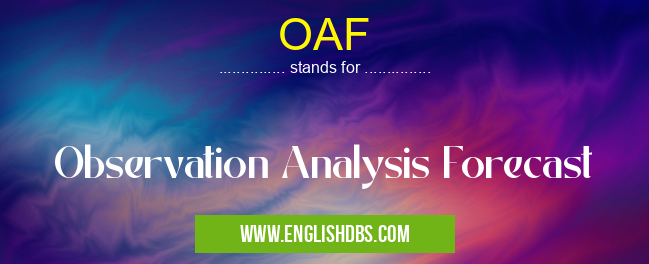What does OAF mean in UNCLASSIFIED
OAF stands for Observation Analysis Forecast. It is a system that combines observations, analysis, and forecasts to provide a comprehensive understanding of current and future weather conditions.

OAF meaning in Unclassified in Miscellaneous
OAF mostly used in an acronym Unclassified in Category Miscellaneous that means Observation Analysis Forecast
Shorthand: OAF,
Full Form: Observation Analysis Forecast
For more information of "Observation Analysis Forecast", see the section below.
Observations
Observations are real-time measurements of weather conditions, such as temperature, humidity, wind speed, and precipitation. These observations are collected from various sources, including weather stations, satellites, and radar.
Analysis
Analysis involves interpreting and synthesizing observations to determine the current state of the atmosphere. Meteorologists use weather charts, models, and other tools to identify weather patterns, fronts, and other features.
Forecasts
Forecasts predict future weather conditions based on observations and analysis. Meteorologists use numerical weather prediction (NWP) models to simulate the evolution of the atmosphere over time. These models incorporate observations, analysis, and physical laws to produce forecasts for various time scales, from short-term (e.g., hourly) to long-term (e.g., seasonal).
Essential Questions and Answers on Observation Analysis Forecast in "MISCELLANEOUS»UNFILED"
What is Observation Analysis Forecast (OAF)?
Observation Analysis Forecast (OAF) is a data assimilation system that combines observations from various sources with a numerical weather prediction (NWP) model to produce a more accurate representation of the atmosphere's current state. It plays a crucial role in improving the accuracy of weather forecasts.
How does OAF work?
OAF operates by blending observations, such as satellite data, radar measurements, and surface station reports, with the output from an NWP model. The observations are used to correct and update the model's initial conditions, resulting in a more accurate forecast.
What are the benefits of using OAF?
OAF provides several benefits, including:
- Improved accuracy of weather forecasts
- Earlier detection and prediction of severe weather events
- Enhanced understanding of atmospheric processes
- Support for decision-making in various sectors, such as aviation, agriculture, and emergency management.
How is OAF used in practice?
OAF is an integral part of weather forecasting systems worldwide. It is used to produce numerical weather predictions by combining observations with model outputs. The resulting forecasts are used by meteorologists, government agencies, and the general public to make informed decisions.
Final Words: The OAF system provides valuable information for decision-making in various sectors, such as agriculture, transportation, and emergency management. By combining observations, analysis, and forecasts, it helps us understand and anticipate weather events, prepare for their potential impacts, and make informed decisions.
OAF also stands for: |
|
| All stands for OAF |
